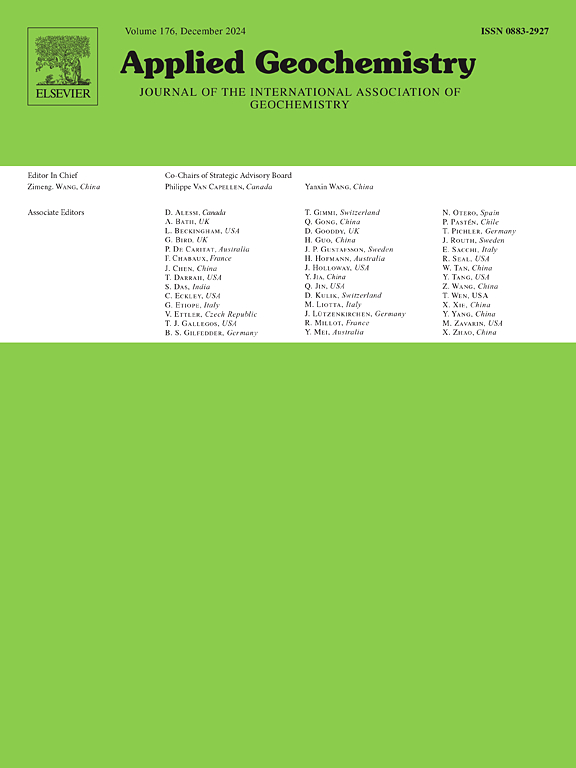利用13C NMR和FTICR MS研究全新世气候变化对palsa沼泽有机质稳定性的影响
IF 3.4
3区 地球科学
Q1 GEOCHEMISTRY & GEOPHYSICS
引用次数: 0
摘要
采用13C核磁共振和高分辨率质谱(HRMS)方法阐明了欧洲北极palsa沼泽泥炭沉积物中土壤有机质(SOM)稳定的主要途径。在全新世不同时期的气候和水文条件下,发现了不稳定/凝聚组分和结构组分的极端值。SOM稳定化的初始阶段包括植物残体的分解,高分子量前体形成(原)腐植酸物质(HSs)分子,以及HS分子的初级转化和最不稳定片段的降解。早全新世(大西洋最适期)和中全新世(SB2期)较有利的气候条件决定了泥炭的植物组成,泥炭以莎草和树莎草群落为主,木质素成分含量高,芳香碎片比例较大,剖面下部和中部层位的腐植酸(HAs)具有热生物动力抗性。经过强烈降解的较老的羟基磷灰石比表层的羟基磷灰石富含含氮、硫的组分。这反过来又伴随着未氧化脂肪和碳水化合物碎片比例的总体下降。在hms中鉴定出相当大比例的高度浓缩片段。结果表明,芳香族和凝聚的透明质酸分子中含有长链取代基,这有助于脂肪碳的含量。由于主要泥炭形成物的再分配,泥炭中戊糖与六糖的比例在泥炭剖面中呈增加趋势。HA分支指数显示长链结构的显著转变和取代脂肪族片段在HA结构中的贡献增加。本文章由计算机程序翻译,如有差异,请以英文原文为准。

A study of palsa bog organic matter stabilization in response to holocene climate change using 13C NMR and FTICR MS
The 13C NMR and high-resolution mass spectrometry (HRMS) methods have been employed to elucidate the principal pathways of soil organic matter (SOM) stabilization in the peat deposit of palsa bogs in the European Arctic. Extremes of labile/condensed constituents and structural moieties have been found to be related to climatic and hydrological conditions during different periods of the Holocene. The initial stage of SOM stabilization includes decomposition of plant residues, formation of (pro)humic substances (HSs) molecules from high-molecular-weight precursors, and primary transformation of HS molecules with degradation of the most labile fragments.
The more favorable climatic conditions of the Early Holocene (Atlantic Optimum) and Middle Holocene (SB2) determined the botanical composition of the peat, which was dominated by sedge and tree-sedge communities with high contents of lignin components and, as a consequence, a greater proportion of aromatic fragments, characterized by thermo-biodynamic resistance in the humic acids (HAs) of horizons in the lower and central parts of the profile. Older HAs, which underwent intense degradation were enriched in the N,S-containing components as compared to HAs from surface layers. This is in turn accompanied by an overall decrease in the proportion of unoxidised aliphatic and carbohydrate fragments. A substantial proportion of highly condensed fragments were identified in HAs by HRMS. It was suggested that aromatic and condensed HA molecules contain long-chain substituents which contribute to the content of aliphatic carbon. The ratio of pentosans to hexosans in HAs is demonstrated to increase down the peat profile as a consequence of the redistribution of the dominant peat formers. The HA branching indices demonstrate a significant transformation of long-chain structures and an increase in the contribution of substituted aliphatic fragments in the HA structure.
求助全文
通过发布文献求助,成功后即可免费获取论文全文。
去求助
来源期刊

Applied Geochemistry
地学-地球化学与地球物理
CiteScore
6.10
自引率
8.80%
发文量
272
审稿时长
65 days
期刊介绍:
Applied Geochemistry is an international journal devoted to publication of original research papers, rapid research communications and selected review papers in geochemistry and urban geochemistry which have some practical application to an aspect of human endeavour, such as the preservation of the environment, health, waste disposal and the search for resources. Papers on applications of inorganic, organic and isotope geochemistry and geochemical processes are therefore welcome provided they meet the main criterion. Spatial and temporal monitoring case studies are only of interest to our international readership if they present new ideas of broad application.
Topics covered include: (1) Environmental geochemistry (including natural and anthropogenic aspects, and protection and remediation strategies); (2) Hydrogeochemistry (surface and groundwater); (3) Medical (urban) geochemistry; (4) The search for energy resources (in particular unconventional oil and gas or emerging metal resources); (5) Energy exploitation (in particular geothermal energy and CCS); (6) Upgrading of energy and mineral resources where there is a direct geochemical application; and (7) Waste disposal, including nuclear waste disposal.
 求助内容:
求助内容: 应助结果提醒方式:
应助结果提醒方式:


